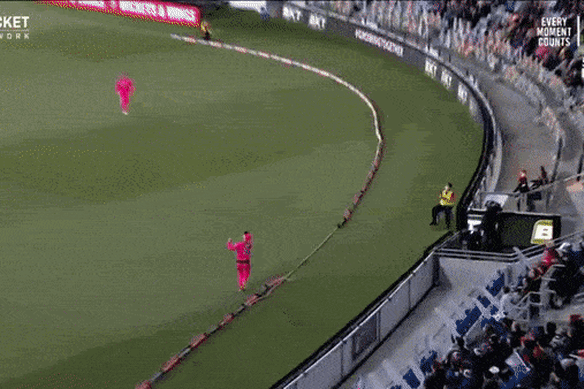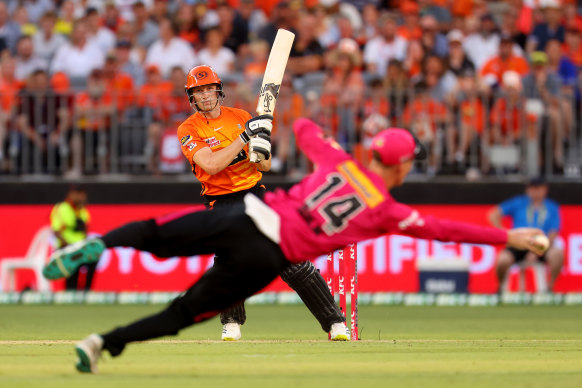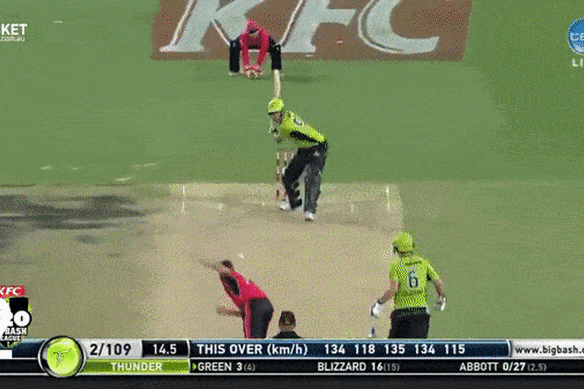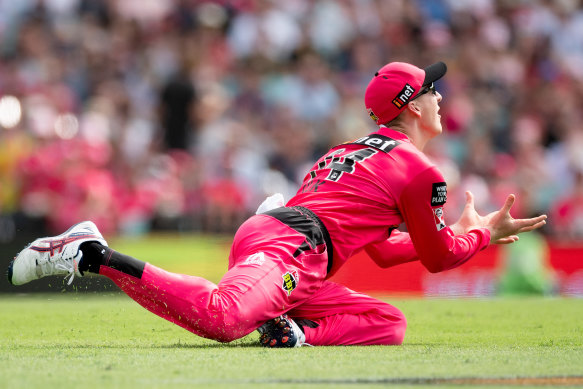Smooth as Silk: The science behind a Big Bash superfielder
Save articles for later
Add articles to your saved list and come back to them any time.
When Jordan Silk earns plaudits for his freakish work in the outfield for the Sydney Sixers, the praise comes in traditional areas: sure hands, steady balance, outstanding speed and athleticism.
But what often gets overlooked when understanding Silk the superfielder is a beautiful mind. And if that sounds a bit like Russell Crowe scribbling on Princeton windows, you’re on the right track.
Silk will take his place on the Sydney Cricket Ground boundary on Friday night in the Sixers’ opening game of the BBL season, and if the past decade is any indication, the 31-year-old will do something incredible while he is there.
As Silk has done in most of his 113 games in magenta that something may be a running catch, or a diving save. Or a running-and-diving combination of the two, like the “Superman” save he pulled off in 2020. Silk is so famed for his fielding people get to the ground early just to watch him warm up.
But what will stand out most is how easy Silk makes it all look. When a ball is hoiked skyward, Silk will glide across the field and deny it a landing. And that’s exactly where the physics calculations come in. If a movie was to be made, the special effects team might overlay Silk seeing projectile motion diagrams.
“You are just trying to find the apex of the ball as soon as possible,” Silk says, when asked what’s going through his head when a ball is hit to the heavens. “I am thinking ‘right, where is it at its highest point? Can I get there quickly and give myself as much time as possible?’.”
Jordan Silk takes a flying leap to save a six in 2020.Credit: Channel 7
The split-second calculations involved in baseballers catching in the outfield were studied in the American Journal of Physics in the 1960s – Google “optical acceleration cancellation” – and most of us have a similar radar to help us play catch at the park.
But when it comes to making a classic catch in the SCG outfield, the radar isn’t enough. You’ll also need a decade of studying bowlers, batsmen, pitch types and hitting habits.
“As you play more cricket you start to understand the trajectory of the ball and you understand how different batters are hitting the ball and how they swing,” Silk said.
“Are they hitting with topspin? Are they hitting it with backspin? If it’s backspin it will travel further so you don’t rush in. If it’s topspin you know it is going to sort of drop on you. That’s just stuff you learn as you go and factors that you keep in mind when you’re on the boundary to prepare you for what to expect.
Cameron Bancroft watches as Jordan Silk takes a diving catch.Credit: Getty
“You learn it as you play, and I have been lucky enough to play for a while. I feel like have a good grasp on a lot of players and what they’re trying to do, and what they’re trying to target late in the innings.”
Penrith-raised Silk started playing for the Sixers in 2013-14, the third season of the BBL, and has been a mainstay ever since. His contributions as a middle-order batsman and gun fielder helped the Sixers win two titles, and finish as runners-up another three times. A screaming catch in 2014 had Ricky Ponting labelling him Australia’s best fielder, and Viv Richards rating him one of the best he’s ever seen.
“Probably as a younger player, coming into that Sixers squad (who had won the 2011-12 BBL), I saw it as my opportunity of playing games,” Silk said.
“I aimed to be the best fielder I possibly and work extremely hard at it, and I think my fielding probably got me games because I was hiding down at six and seven with the bat and not getting many opportunities there. But I felt like I could contribute in the field.”
Jordan Silk times an epic running catch.Credit: Network Ten
His training regimen is more short-and-focussed than his eager early days, but Silk still prepares for all scenarios.
“We are constantly practising difficult catches, catches on the run, catches into the sun and lights, things like that,” he said. “It is more a trust thing for me. Knowing I have done the work.”
In part because of his fielding heroics, Silk’s batting is undervalued. In a league of rope-clearing hitters, the right-hander is more of a gap-finding finisher in the mould of Michael Bevan, and though it’s without the rocket-fuelled strike rate of some, it’s effective. Silk is the Sixers’ second-highest run-scorer of all time and their top scorer last season.
But those run tallies don’t even take into account another calculation that whirs through Silk’s mind every time he dives over the rope to stop a six, or hustle to restrict a two into a single.
Jordan Silk takes a low catch.Credit: Getty
“I see the fielding side accumulates into batting,” Silk said.
“I might not have the best strike rate (124) or anything like that, with the bat. But I almost try and get ahead of that, with how many runs can I cut off in the field? And maybe propel your average from a 25/30 player to someone who maybe gets seen as a bloke who gives more value, because he’ll save us five to 10 runs in the field.
“That stuff adds up, particularly if a number of people are doing it.
“They’re all little moments that we don’t let slip in the change room. We know the value of runs in T20 cricket. Every run you can stop can help you win games.”
Sports news, results and expert commentary. Sign up for our Sport newsletter.
Most Viewed in Sport
From our partners
Source: Read Full Article



